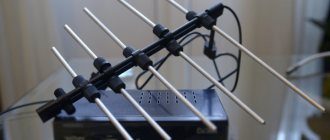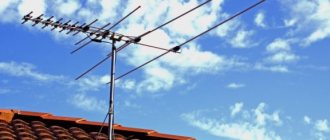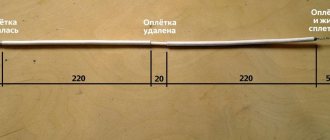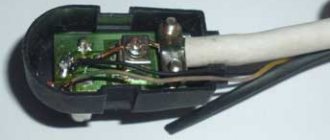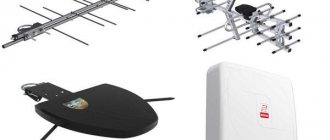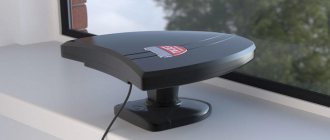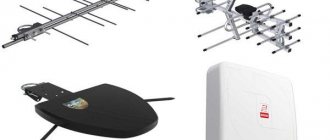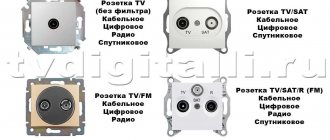Digital television will soon completely displace analogue broadcasting from everyday life. Just ten years ago, a relatively small part of the population could appreciate its capabilities, but today it has grown from a novelty into a necessity. This happened for several reasons: the entry into the market of a large number of digital TV models at an affordable price, government initiatives aimed at a gradual transition from analogue to digital broadcasting, and simply because of the obvious advantages of this type of signal transmission.
However, most users still do not understand what a TV should be like to display a digital image, how some models differ from others, and what parameters they should pay attention to when purchasing. In our article we will try to help you approach the process of choosing a digital TV correctly, so that the user understands what exactly he is paying his money for and his decision in favor of one or another model is conscious.
How many channels should there be?
Federal channels on digital TV are transmitted in two packages (multiplexes), RTRS-1 and RTRS-2, each with 10 channels. The exception is the cities of Moscow, Sevastopol and the territory of Crimea, where 3 packages of 10 channels are available.
Broadcasting of the third multiplex, which will contain both federal and regional channels, is due to begin soon. In Moscow, this package is already working in test mode. Broadcasting is not 24/7. From 7 to 19 channels will be available.
In addition to television channels, the packages also contain broadcasts from 3 radio stations (“Vesti-FM”, “Mayak” and “Radio Russia”).
Sometimes it happens that one of the packages is not available. Then the user can watch only 10 channels instead of 20. Let's look at the most common causes of such failures.
Dates for the transition to DTV in the capital and Moscow region in 2019
The transition from analogue to digital broadcasting in Russia is carried out in stages. In Moscow and the Moscow region, the shutdown will begin on April 15, 2021 and will affect exclusively users of terrestrial television broadcasting, of which there are only 1% in the region. The remaining households are connected to cable television or use satellite or Internet television. In this regard, preparations are made in advance for receiving a digital signal.
There is an emergency exit
Is it possible to somehow watch your favorite program if the TV does not receive the desired channel for some reason? The answer is yes. And IPTV will help with this.
If your TV can be connected to a network via Wi-Fi or an Ethernet-to-Ethernet cable, you must first set up the network. Typically, all you have to do is follow the on-screen prompts.
Now almost every channel has developed its own Internet application. If you install it, you can watch live broadcasts or individual programs in recording.
An alternative way is to use one of the IPTV players for Smart TV and load a self-updating playlist into it.
Another universal application is mts.tv. All federal (and some other) TV channels can be watched in good quality in this application for free.
Another option is to watch the channel’s live broadcast directly in your browser. Some channels are shown by Yandex on the website tv.yandex.ru.
Well, as a last resort, you can watch TV channels directly on the screen of a personal computer, laptop or tablet using IPTV players for Windows.
The nuances of watching TV through a shared antenna
A collective antenna for digital television provides broadcasting of channels under the same contract as in the case of an individual connection. The intermediary is the housing company. The standard tariff plan, available to all subscribers, includes federal TV channels, as well as several regional programs.
As for paid channels, narrowly focused programs are mainly presented here - sports broadcasts, music videos, etc. An individual cable television connection allows you to select the set of necessary channels. The use of a collective antenna assumes that the subscriber selects one of the available paid tariffs.
Why does digital TV freeze?
Conventionally, the reasons why digital television disappears can be divided into 3 groups:
- Connection cable problems. Most digital set-top boxes come complete with RSA wires; they are also called “Tulips”. They are quite unreliable during long-term use and can break down with use. HDMI and SCART cables are more reliable in this regard. We also wrote about them in the instructions for setting up channels.
- Antenna problem. In most such situations, the culprit of errors and signal freezes is the antenna. We are often approached with a similar problem and we once again say that if your antenna previously picked up analogue channels, it is not a fact that it will be able to do this with digital ones. We wrote earlier here about the correct choice and calculation for the figure. Let’s just say briefly that the selection should be carried out depending on the distance of the main television tower. For distances up to 7 km, ordinary indoor antennas with an amplifier are suitable. Anything above should be caught by outdoor antennas with increased gain.
- Failures and prevention at the station. Unfortunately, the numbers are just developing. Because of this, temporary disruptions or planned maintenance work may occur at a number of stations. We constantly write about them and notify subscribers. Work is often carried out to improve signal strength and increase the range of translators. However, the cause of disappearances is often the weather.
Thus, for most problems with freezes and lack of digital television signal, the receiving equipment is to blame. Therefore, before calling the hotline numbers, you need to make sure in advance that all actions on your part have been completed and the signal can be received and processed without hindrance.
Why doesn't my digital set-top box pick up channels?
When we touch on this issue, we mean a set of problems that can arise with any owner of digital equipment. Therefore, when troubleshooting, it is necessary to check all possible issues that may arise if the set-top box itself is operational:
Incorrect antenna setting
This is a fundamental problem for all subscribers. Often, if we are asked why the set-top box does not pick up channels, we point to the antenna.
- Firstly, you need to choose it correctly. This is done depending on the distance of the house from the TV tower. If this distance exceeds 10-12 km, then an outdoor antenna with a powerful amplifier is required.
- Secondly, proper installation is also required. It must be done as close as possible to the console. If we consider a private house, then it is best to place an outdoor antenna directly in front of the window or behind the wall where the TV itself is located. You should also turn it in the direction in which the TV tower is supposed to be located. At the same time, at a distance of 10-20 meters, it is desirable that there are no buildings or forests in front of the antenna. This will reduce its power.
Poor quality connection cables
Many problems with digital television arise from bad wires:
- Antenna cable. Special attention to him. Cheap options are made from low-quality materials and the service life of such a cable varies from six months to a year. Moreover, no one will give you a guarantee of its quality, not even a store. Imagine that even in expensive cables, 30-40 rubles per meter, there is so-called “attenuation” of the signal, albeit negligible. What can we say about cheap options? We especially urge apartment owners not to “cheap”, since their antennas are usually located on the roof of the house, and the cable length can reach over 10 meters.
- Set-top box connection wires. RSA cables are usually included with the equipment. They are often made of low-quality alloys and quickly become unusable. We think that the manufacturer places them in order for the subscriber to simply make sure that the set-top box is working and nothing more. However, the set-top box should still be able to pick up channels even if these wires are faulty. If they become unusable, the device will simply stop showing up on the TV screen or will begin to freeze with the sound disappearing.
Incorrect channel settings
Again, the equipment is not always to blame for the lack of search. Often, out of ignorance, subscribers configure it incorrectly and, as a result, channels cannot be found. We have written about this procedure more than once. For clarity, we will repeat again. Let's say right away that we will do the setup through a manual search. You can find it in the device menu:
- First, go to the interactive map of CETV and look at the broadcast frequency of RTRS-1 and RTRS-2 for your region. We write down the TVK channel numbers.
- After that, go to the console menu and select manual search.
- A window will open in which you will need to enter the TVC data that you previously looked at on the interactive map. This should be done for both numbers.
These are the most common problems that arise if the set-top box does not pick up channels.
General recommendations
After the transition to digital TV, residents of Russian cities had the opportunity to watch 20 television channels in good quality. But it happens that only half of them are available. What to do in this case?
First of all, you need to establish the reason:
- check whether repair or maintenance work is ongoing on the repeater;
- connect the antenna through the set-top box and find its best position;
- check the tuner settings and, if necessary, manually tune to the frequency of the missing channel package;
- make sure the TV is working properly.
If all of the above methods do not help, you can watch TV by connecting it to the Internet (many modern models allow this). In this case, the TV screen becomes analogous to the screen of a computer or tablet.
By installing the application of the selected channel (the main federal channels have developed them and are easy to find in the application store), you can watch not only live broadcasts, but also missed ones (recorded).
Popular amplifiers
Popular and common devices include:
- Televes The device, created by an Italian manufacturer, has five outputs. A gain of 16 dB ensures low noise and interference. Operates from a separate power supply included in the kit.
- Terra HA123 is an excellent solution for an apartment or country house. Has a gain of 28 dB. The presented device operates at different frequencies. The noise figure does not exceed 30 dB.
- Gecen A05-02. The presented option is suitable for terrestrial and satellite TV. For satellite television, the operating range is from 950 to 2400 MHz, and for terrestrial television from 5 to 950 MHz. It receives power through a coaxial cable that comes from the satellite tuner.
- SWA from a Polish manufacturer. The devices are mounted on the antenna itself. The devices offered in the range have different QUs, and the frequency range is 49-790 MHz.
How to boost a bad digital TV signal
The most effective ways to boost your antenna's digital signal. Possible errors and step-by-step elimination and identification of the problem of lack of a normal signal.
Usually, when setting up digital TV, it can be extremely difficult to find channels. In this case, some set-top boxes begin to freeze or display messages about the absence of a signal. The problem in this regard is familiar to us firsthand. The culprit is often a bad signal. If its level is insufficient, then it is extremely difficult to do anything. The set-top box simply will not have the technical ability to catch the broadcast.
Fortunately, a lot of ideas and advice have already been invented on this matter. And as practice shows us, today’s subscribers complain about this problem most often. That’s why we’ll look at it under a microscope and try to provide actionable advice on how you can strengthen a bad digital television signal.
Pros and cons of a collective antenna
The main purpose of this type of receiver is to provide all residents of apartment buildings with digital TV. The collective antenna in Moscow allows you to configure all channels. It will become an effective analogue of an indoor TV antenna. Experts highlight the following advantages of this device:
- high quality reception. The collective TV antenna is installed by specialists, not by the residents of the house. They know the specific location of the area, so they choose the optimal point for installing the receiver;
- free service. The cost of antenna repair and installation is borne by the housing utility company;
- users will be able to simultaneously set up analogue and digital television. In the future, you can connect pay cable TV;
- A resident of an apartment building will be able to set up TV broadcasting immediately after arrival. No additional equipment required.
There is only one drawback - the subscription fee for use, which is initially included in utilities.
If the signal is poor or missing
During the analysis process, we will not touch on obvious problems associated with defective equipment. You can meet him on rare occasions. In addition, before you start, make sure that your digital broadcast receiver (set-top box or TV) works with the DVB-T and DVB-T2 standards.
In general, most poor signal level problems are due to:
- Poor tuning and antenna selection. We wrote earlier about who will need a digital antenna and how to choose it. In general, I can only say that its choice depends on how far the TV tower transmitting the signal is from you. The farther it is (from 10 km), the better the antenna should be. This problem is the main reason why the signal is missing or disappears temporarily.
- Cheap TV wire. To be honest, almost 90% of television equipment in our market is made in China. This is a problem because the quality of these products is not always up to par. In hardware stores you will be offered at least 2 types of television cable. The first one is simpler and will cost a penny, the second one is a little more reliable. It's worth taking the last option. Cheap cables are of extremely poor quality and, over time, stop transmitting the signal normally. While the impulse from the antenna reaches the set-top box, its strength will be reduced several times due to losses in the wire. Therefore, we urge you not to skimp when choosing it.
- No amplifier on long cables. It is not always possible to place the antenna within 1-10 meters. This is especially true for high-rise buildings, where the digital cable can stretch 20-30 meters. In this case, significant signal loss and deterioration in its overall quality are possible. For such options, a special digital signal amplification was invented. It allows you to reduce the impact of interference on broadcast transmission and helps improve broadcasting on wires over 10 meters. However, it should be connected depending on the situation. If you are in the countryside, where there should be minimal interference, you should connect the amplifier closer to the TV. Otherwise, it is best to use it near the antenna. Its price does not exceed 500 rubles.
Thus, we have provided you with 3 obvious reasons for poor signal strength. As you can see, they are mainly connected to the antenna. When searching for channels, we recommend doing this only in manual mode. You can find out the frequency of reception in your region on the interactive map of CETV.

